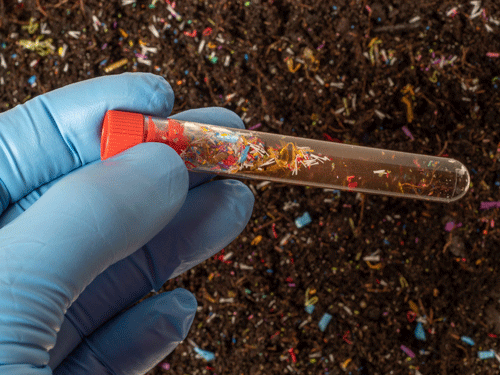
Microplastics are extremely small pieces of plastic debris that result from the disposal and breakdown of consumer products and industrial waste. These pieces of plastic can be nano-sized, measuring at less than 5 millimeters in diameter. Microplastics can come from various sources including larger plastic debris, like water bottles and straws, that disintegrate over time by grinding larger materials down in wastewater treatment facilities, microfiber shed from clothing and textiles and even microbeads prevalent in many cosmetic products. Tiny microplastic particles can take thousands of years to decompose, while causing alarming environmental issues.
How Microplastics Enter Our Waterways
Microplastics can enter our waters in many ways—from littering to the result of storms, one of the most prominent ways is through the indiscriminate flushing of modern trash. Disinfecting wipes, coated with a plastic constituent for increased ruggedness and durability when cleaning, is just one example of prolific modern trash that should not be flushed. An increase in flushing of these nondispersables started around 2008 and only continued to grow, especially during the COVID-19 lockdown. When toilet paper was not available, people started using the next best thing—wipes. At the time, we had no idea how the COVID-19 virus was spreading, and after using a wipe to clean, the quickest way to dispose of it was to flush it down the toilet.
Once nondispersables are flushed, they coast through a treatment process at wastewater facilities. First, the nondispersable items, sludge and other waste will flow into the pump impellers. Older wastewater solids-handling pump systems, derivatives of a design from 1915, generally have a two-channel impeller with vertical leading edges that can pass a 3-inch solid. These types of impellers cannot handle modern trash, clogging incredibly easily and often.
To mitigate this clogging, many utilities installed grinders to break up the materials into quarter-inch squares or less. This way, older pumps can effectively pass smaller solids through the system. We have seen explosive growth of grinder installations prior to and throughout COVID-19. During the pandemic, loading at wastewater treatment plants was 300% higher than levels before COVID-19 due to the mass of extra debris coming into the utilities. Today, the United States Environmental Protection Agency (EPA) reports that the loading mass has decreased to 150%.
Although the grinders solve the clogging problem, we now have a much larger and more troubling problem on our hands. Once the trash is sent through the grinder, materials that have a plastic component are chopped up, releasing microplastics at a higher volume than if the materials were left to break down on their own. Small microplastics pass unchanged through treatment plants, into waterways and eventually, into the ocean.
Microplastics Wreak Havoc on Our Environment
As a pollutant, microplastics can be harmful to the environment and animal health. In open waters, microplastics are often consumed by marine animals who mistake the particles for food. Once ingested, fish, birds, crabs, sea turtles and other animals can experience digestive blockages, damaging biological effects and issues with reproduction that can be fatal.
A 2021 study by Change Biology suggested that the rate of plastic consumed by fish has doubled in the last decade and is increasing by more than 2% every year. Other marine animals and humans who eat contaminated fish, oysters, mussels and other wildlife can have microplastics in their bodies forever.
What Can We Do to Mitigate Consequences From Microplastics?
Looking toward the future, the treatment and removal of microplastics should be a top priority for individuals, treatment plants and governing bodies.
The more than 16,000 wastewater treatment systems in the U.S. that use grinders as a band-aid solution to an outdated system could switch to a modernized pumping solution. Modern pumps that have horizontal leading edges can be wiped clean every time the pump rotates as wastewater and sludge come in. Instead of becoming clogged, the system can sustain cleanliness and high efficiency without using grinders. Down the line, utilities may consider installing a third or fourth section of the treatment process to make sure microplastics stay out of our receiving waters.
At home, consumers can be more discerning about what they are flushing down the toilet or even purchasing at the store. Wipes that do not end up in an ocean will end up in a landfill, releasing microplastics there too. Be cautious of littering and using single-use plastics such as produce bags, plastic straws, coffee cups, food packaging and more.

